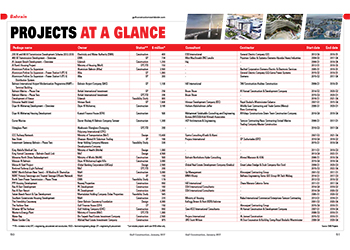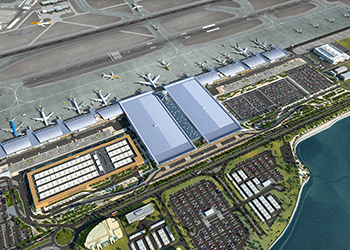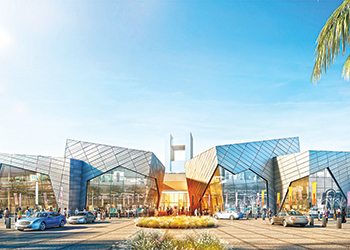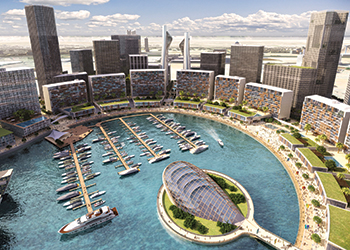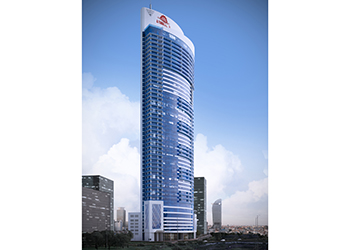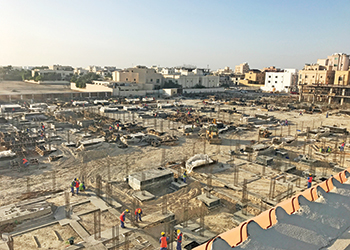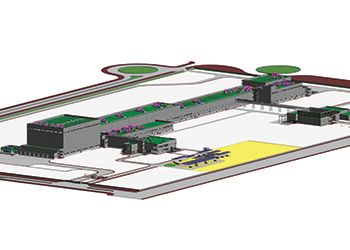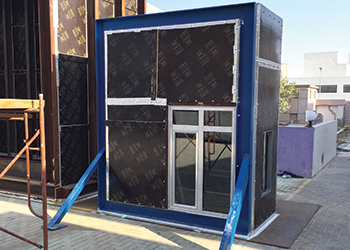
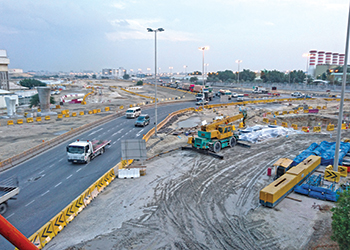 Alba interchange ... work progressing.
Alba interchange ... work progressing.
The Ministry of Works, Municipalities Affairs and Urban Planning (MoWMUP) is gearing up to kick-start work on the second phase of the Muharraq Ring Road project, having recently launched construction on the Alba-Nuwaidrat interchange, among a number of key projects.
“The concept design scheme is expected to be finalised by January 2017 for the Muharraq Ring Road project, which is currently in the feasibility stage,” a spokesman for the ministry tells Gulf Construction.
“Detail design studies are expected to be completed by end of Q4 of 2017, following which tender announcements for the main works (roads and structures including the signature bridge) to be announced.”
The MoWMUP is currently in the process of shortlisting contractors for the reclamation and main works for the project. Tenders for Package One of reclamation works are expected to be announced in February for the shortlisted bidders, with work on this packaged to be finished in Q3 of 2017. Package-Two reclamation works will begin subsequently, he adds.
Ring road
The Muharraq Ring Road Project, which last year saw the completion of its first phase, is a strategically important project. It serves traffic along the internal roads and is used as an alternative to Raya Avenue (former Aradus Avenue), carrying traffic to Galali, Samaheej and Dair – areas which have seen a housing boom.
Phase Two of the Muharraq Ring Road along with the Fourth Bridge connecting Manama to Muharraq, will alleviate pressure on the Airport Highway, Ghous Avenue and Khalifa Al Kabir Highway, serve economic and housing projects in the north of Muharraq, and will enhance traffic movement to Bahrain International Airport and Khalifa bin Salman Port.
Meanwhile, work is in progress on the revamp of Alba and Nuwaidrat interchanges on Sheikh Jaber Al Ahmad Al Sabah Highway – one of the oldest in Bahrain, connecting Manama to the industrial areas of Sitra, Ma’ameer and Eker and providing access to Sanad, Isa Town and Awali. The highway also connects the industrial area surrounding the project to both Mina Salman and Khalifa bin Salman Port.
The Nuwaidrat flyover involves the installation of 153 piles of 1 m diameter and about 10 m deep. An in-situ concrete system using the post-tensioning technique will be used to construct the bridge.
The development is among several projects covering the roads, sanitary and construction sectors being implemented by the ministry in a bid to provide a world-class infrastructure in the country in line with Bahrain Economic Vision 2030.
“The ministry has continued to achieve success with many projects it has implemented. A number of important roads projects are progressing well in line with the ministry’s strategic plan. We saw an outstanding year in 2016, reflected in the infrastructure projects undertaken, whether in the roads, sanitary or strategic building sectors,” says the spokesman.
Work is also nearing completion on the first phase of the Jasra Interchange revamp. Phase One of the project involves constructing a new slope to link Janabiya Highway to Sheikh Isa bin Salman Highway and revamping of the existing slopes to improve traffic flow along the highway.
The revamp of Sheikh Isa bin Salman Highway facilitates transport of goods by providing a free non-stop traffic flow on all interchanges of the highway from Khalifa bin Salman Port in the east to King Fahad Causeway in the west. This has contributed to reducing peak times and journey duration from 40 minutes to 18 minutes, says the spokesman.
Other projects
Elsewhere, the ministry has paved a total of 60 km of roads and provided them with proper stormwater drainage network, lighting and traffic signage.
It has also has revamped 20 villages as part of its Villages Revamp Programme. This included revamping roads and alleyways, removing old and deteriorated dirt layers, extending new electricity, water and stormwater drainage networks and lighting services.
In addition, the ministry has established the Complete Municipal Centre, which will act as a hub for liaison between customers and service entities and municipalities, thus accelerating the pace of investment in the country.
Among other achievements, about 95 per cent of the population has been successfully connected to the sewerage network.
The MoWMUP is also looking at forging partnerships with the private sector to drive infrastructural growth further. A pioneering project in this direction was the Muharraq Sewerage Project.





















_0001.jpg)


.jpg)
















.jpg)








.jpg)



